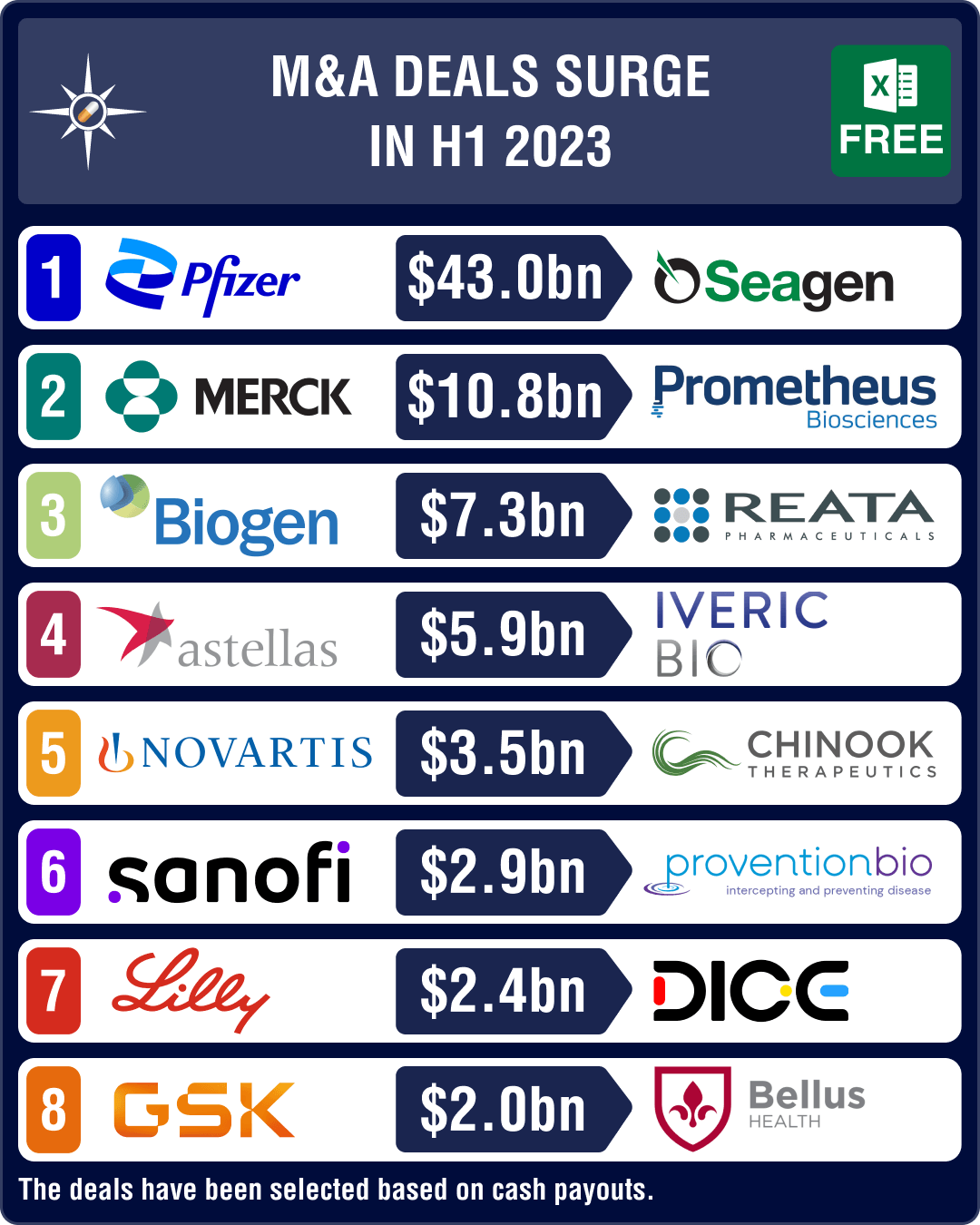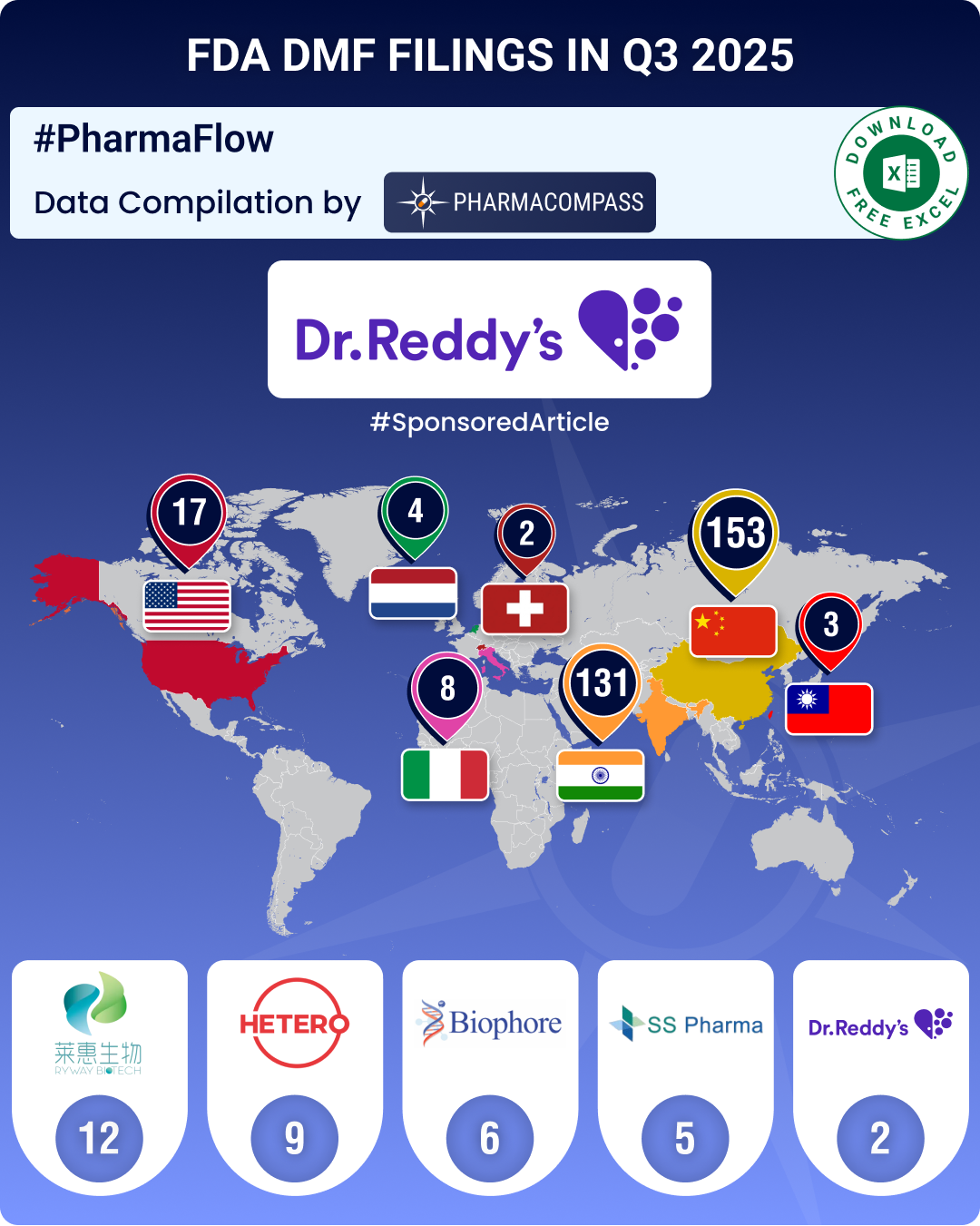
By PharmaCompass
2023-09-21
Impressions: 4644
After a year when dealmaking faced several challenges, such as high interest rates and inflation and fears of a looming recession, the first half of 2023 (H1 2023) did show some signs of recovery.
During this period, the biopharma industry witnessed a surge in high-profile mergers and acquisitions (M&As). Our analysis shows that total M&As during H1 2023 reached US$ 81.2 billion, as compared to US$ 89.6 billion for the full year 2022. By September 15, 2023, the total M&A deal value — at US$ 94.2 billion — had surpassed the total deal value for 2022.
PharmaCompass has noticed a shift in deal trends, particularly in modalities. For instance, biologics made up for 46 percent of all deals in H1 2022, and rose to over 50 percent in H1 2023, suggesting a growing interest in biologics.
Oncology and immunology are two key therapeutic areas that have seen significant scientific breakthroughs in recent years. Oncology witnessed 28 deals, worth a total of US$ 45 billion, followed by immunology with seven deals at approximately US$ 14 billion.
Our data does not include deals related to acquisition of products or facilities, divestment, medical devices, diagnostics and animal health. We have considered only deals announced in H1 2023, irrespective of when these transactions were completed.
View Pharma & Biotech M&A Deals from Jan. to Mid-Sept. 2023 (Free Excel Available)
Pfizer-Seagen, Merck-Prometheus amongst biggest transactions of H1 2023
The biggest transaction of H1 2023 was Pfizer’s acquisition of Seagen for US$ 43 billion, announced in March. The deal is part of Pfizer’s move to mitigate a hit in revenues from declining sales of its Covid-19 products and the imminent expiration of patents for some of its top drugs.
As part of the deal, Pfizer will gain access to Seagen’s four approved cancer therapies, collectively generating nearly US$ 2 billion in sales in 2022. This strategic acquisition bolsters Pfizer’s existing and impressive portfolio of 24 approved oncological therapies.
The second largest deal of H1 was Merck’s purchase of Prometheus for US$ 10.8 billion in April. The deal is centered around the potential of Prometheus’ candidate in phase 2 trials — PRA023 (now MK-7240) — to treat ulcerative colitis and Crohn’s disease. Merck’s CEO Robert Davis anticipates MK-7240 to be a multibillion-dollar drug.
Around the same time as the Merck-Prometheus deal, Japanese drugmaker Astellas Pharma announced the acquisition of New Jersey-based eye drug developer Iveric Bio for US$ 5.9 billion. Last month, the US Food and Drug Administration (FDA) approved Iveric’s intravitreal solution for the treatment of geographic atrophy — Izervay (avacincaptad pegol).
Another significant deal announced in April was GSK’s US$ 2 billion buyout of Canada-based late-stage biopharmaceutical company Bellus Health. The acquisition is expected to further strengthen GSK’s specialty medicines and respiratory products.
View Pharma & Biotech M&A Deals from Jan. to Mid-Sept. 2023 (Free Excel Available)
Sanofi, Lilly, Novo Nordisk forge deals to strengthen diabetes, obesity portfolios
Over the last six months, drugmakers like Sanofi, Eli Lilly, and Novo Nordisk have beefed up their diabetes and obesity drug portfolios through acquisitions. The biggest deal in this field was Sanofi’s acquisition of US-based Provention Bio for US$ 2.9 billion to access diabetes drug Tzield, the first and only therapy approved by the FDA to delay the onset of stage 3 type 1 diabetes (T1D) in adults and pediatric patients. This acquisition builds on a co-promotion agreement Provention Bio had signed with Sanofi in October 2022, one month prior to FDA’s approval of Tzield.
In July, Eli Lilly had announced the acquisition of Versanis for a potential value of US$ 1.9 billion. The deal will give Lilly access to phase 2 drug bimagrumab, a monoclonal antibody for the treatment of obesity and cardio-metabolic diseases. In June, Eli Lilly had announced the acquisition of Sigilon Therapeutics for about US$ 344.2 million to gain access to Sigilon’s cell therapy candidate SIG-002 for the treatment of type 1 diabetes. The same month, Lilly had announced the acquisition of Dice Therapeutics for around US$ 2.4 billion in order to bolster its immunology pipeline. The deal will grant Lilly access to Dice’s experimental drugs DC-806 (for treating psoriasis) and DC-853 (for treating a variety of autoimmune and inflammatory diseases).
Post the Eli Lilly-Versanis deal, Novo Nordisk announced the acquisition of Inversago Pharma for up to US$ 1.1 billion to access the company’s lead development asset INV-202, an oral cannabinoid receptor blocker. INV-202 demonstrated weight loss potential in a phase 1 trial and is currently in a phase 2 trial for diabetic kidney disease.
View Pharma & Biotech M&A Deals from Jan. to Mid-Sept. 2023 (Free Excel Available)
Biogen, Novartis, Sobi announce buyouts in rare disease segment; Astra buys CinCor
The rare disease segment witnessed a significant deal in July when Biogen announced the acquisition of Reata Pharmaceuticals for US$ 7.3 billion. The deal gave Reata access to rare disease drug Skyclarys (omaveloxolone), the first and only FDA-approved treatment for Friedreich’s ataxia (rare genetic neurodegenerative movement disorder) in adults and adolescents aged 16 years and older. Omaveloxolone was approved by the FDA in February 2023.
In June, Novartis had announced acquisition of American biotech Chinook Therapeutics for up to US$ 3.5 billion to expand its renal portfolio. Novartis will develop and commercialize Chinook’s lead asset and late-stage drug candidates atrasentan and zigakibart for IGA nephropathy, a rare kidney disease. In May, Swedish blood disorder specialist Sobi has acquired Seattle-based CTI BioPharma for US$ 1.7 billion, gaining access to the FDA-approved Vonjo, a novel targeted therapy for blood-related cancers known as cytopenic myelofibrosis.
In January, Italy’s Chiesi Farmaceutici bought Ireland-based rare diseases drugmaker Amryt Pharma for up to US$ 1.48 billion. This deal includes Amryt’s approved drug, Filsuvez for epidermolysis bullosa, an inherited skin disease, which is approved in Europe. The same month, AstraZeneca acquired US-based drug developer CinCor Pharma for up to US$ 1.8 billion. The acquisition is expected to boost Astra’s cardio-renal pipeline with the addition of baxdrostat, a small oral molecule currently in phase 1 trial for the treatment of hypertension. Astra is optimistic about its potential in treating high blood pressure and chronic kidney disease, especially when used in combination with its blockbuster drug Farxiga for cardio-renal diseases.
View Pharma & Biotech M&A Deals from Jan. to Mid-Sept. 2023 (Free Excel Available)
Our view
According to a report by Bain & Company, global M&A value was down 44 percent in the first five months of 2023. The report cites factors such as macroeconomic and interest rate uncertainties to be complicating matters for both potential buyers and sellers. We can take heart from the fact that in comparison to the global data, M&As in the biopharma sector have actually grown in H1 2023.
Going forward, there are several factors that suggest deal making in the biopharma sector will pick up further. These include factors such as attractive valuations of biotechs, rising cash reserves of big pharma coupled with cash crunch being faced by several biotechs, and patent cliffs and loss of market exclusivity threatening the revenues of several large drugmakers. In short, H2 2023 is poised to be a lot different.
The PharmaCompass Newsletter – Sign Up, Stay Ahead
Feedback, help us to improve. Click here
Image Credit : Top Pharma & Biotech M&A Deals from Jan. to Mid-Sept. 2023 by PharmaCompass license under CC BY 2.0
“ The article is based on the information available in public and which the author believes to be true. The author is not disseminating any information, which the author believes or knows, is confidential or in conflict with the privacy of any person. The views expressed or information supplied through this article is mere opinion and observation of the author. The author does not intend to defame, insult or, cause loss or damage to anyone, in any manner, through this article.”








